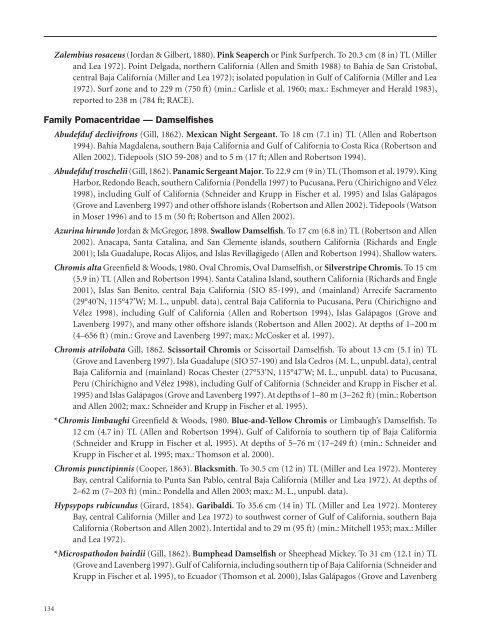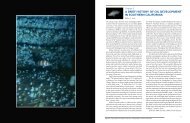checklist (pdf) - The Love Lab - University of California, Santa Barbara
checklist (pdf) - The Love Lab - University of California, Santa Barbara
checklist (pdf) - The Love Lab - University of California, Santa Barbara
Create successful ePaper yourself
Turn your PDF publications into a flip-book with our unique Google optimized e-Paper software.
Zalembius rosaceus (Jordan & Gilbert, 1880). Pink Seaperch or Pink Surfperch. To 20.3 cm (8 in) TL (Miller<br />
and Lea 1972). Point Delgada, northern <strong>California</strong> (Allen and Smith 1988) to Bahia de San Cristobal,<br />
central Baja <strong>California</strong> (Miller and Lea 1972); isolated population in Gulf <strong>of</strong> <strong>California</strong> (Miller and Lea<br />
1972). Surf zone and to 229 m (750 ft) (min.: Carlisle et al. 1960; max.: Eschmeyer and Herald 1983),<br />
reported to 238 m (784 ft; RACE).<br />
Family Pomacentridae — Damselfishes<br />
Abudefduf declivifrons (Gill, 1862). Mexican Night Sergeant. To 18 cm (7.1 in) TL (Allen and Robertson<br />
1994). Bahia Magdalena, southern Baja <strong>California</strong> and Gulf <strong>of</strong> <strong>California</strong> to Costa Rica (Robertson and<br />
Allen 2002). Tidepools (SIO 59-208) and to 5 m (17 ft; Allen and Robertson 1994).<br />
Abudefduf troschelii (Gill, 1862). Panamic Sergeant Major. To 22.9 cm (9 in) TL (Thomson et al. 1979). King<br />
Harbor, Redondo Beach, southern <strong>California</strong> (Pondella 1997) to Pucusana, Peru (Chirichigno and Vélez<br />
1998), including Gulf <strong>of</strong> <strong>California</strong> (Schneider and Krupp in Fischer et al. 1995) and Islas Galápagos<br />
(Grove and Lavenberg 1997) and other <strong>of</strong>fshore islands (Robertson and Allen 2002). Tidepools (Watson<br />
in Moser 1996) and to 15 m (50 ft; Robertson and Allen 2002).<br />
Azurina hirundo Jordan & McGregor, 1898. Swallow Damselfish. To 17 cm (6.8 in) TL (Robertson and Allen<br />
2002). Anacapa, <strong>Santa</strong> Catalina, and San Clemente islands, southern <strong>California</strong> (Richards and Engle<br />
2001); Isla Guadalupe, Rocas Alijos, and Islas Revillagigedo (Allen and Robertson 1994). Shallow waters.<br />
Chromis alta Greenfield & Woods, 1980. Oval Chromis, Oval Damselfish, or Silverstripe Chromis. To 15 cm<br />
(5.9 in) TL (Allen and Robertson 1994). <strong>Santa</strong> Catalina Island, southern <strong>California</strong> (Richards and Engle<br />
2001), Islas San Benito, central Baja <strong>California</strong> (SIO 85-199), and (mainland) Arrecife Sacramento<br />
(29°40'N, 115°47'W; M. L., unpubl. data), central Baja <strong>California</strong> to Pucusana, Peru (Chirichigno and<br />
Vélez 1998), including Gulf <strong>of</strong> <strong>California</strong> (Allen and Robertson 1994), Islas Galápagos (Grove and<br />
Lavenberg 1997), and many other <strong>of</strong>fshore islands (Robertson and Allen 2002). At depths <strong>of</strong> 1–200 m<br />
(4–656 ft) (min.: Grove and Lavenberg 1997; max.: McCosker et al. 1997).<br />
Chromis atrilobata Gill, 1862. Scissortail Chromis or Scissortail Damselfish. To about 13 cm (5.1 in) TL<br />
(Grove and Lavenberg 1997). Isla Guadalupe (SIO 57-190) and Isla Cedros (M. L., unpubl. data), central<br />
Baja <strong>California</strong> and (mainland) Rocas Chester (27°53'N, 115°47'W; M. L., unpubl. data) to Pucusana,<br />
Peru (Chirichigno and Vélez 1998), including Gulf <strong>of</strong> <strong>California</strong> (Schneider and Krupp in Fischer et al.<br />
1995) and Islas Galápagos (Grove and Lavenberg 1997). At depths <strong>of</strong> 1–80 m (3–262 ft) (min.: Robertson<br />
and Allen 2002; max.: Schneider and Krupp in Fischer et al. 1995).<br />
*Chromis limbaughi Greenfield & Woods, 1980. Blue-and-Yellow Chromis or Limbaugh’s Damselfish. To<br />
12 cm (4.7 in) TL (Allen and Robertson 1994). Gulf <strong>of</strong> <strong>California</strong> to southern tip <strong>of</strong> Baja <strong>California</strong><br />
(Schneider and Krupp in Fischer et al. 1995). At depths <strong>of</strong> 5–76 m (17–249 ft) (min.: Schneider and<br />
Krupp in Fischer et al. 1995; max.: Thomson et al. 2000).<br />
Chromis punctipinnis (Cooper, 1863). Blacksmith. To 30.5 cm (12 in) TL (Miller and Lea 1972). Monterey<br />
Bay, central <strong>California</strong> to Punta San Pablo, central Baja <strong>California</strong> (Miller and Lea 1972). At depths <strong>of</strong><br />
2–62 m (7–203 ft) (min.: Pondella and Allen 2003; max.: M. L., unpubl. data).<br />
Hypsypops rubicundus (Girard, 1854). Garibaldi. To 35.6 cm (14 in) TL (Miller and Lea 1972). Monterey<br />
Bay, central <strong>California</strong> (Miller and Lea 1972) to southwest corner <strong>of</strong> Gulf <strong>of</strong> <strong>California</strong>, southern Baja<br />
<strong>California</strong> (Robertson and Allen 2002). Intertidal and to 29 m (95 ft) (min.: Mitchell 1953; max.: Miller<br />
and Lea 1972).<br />
*Microspathodon bairdii (Gill, 1862). Bumphead Damselfish or Sheephead Mickey. To 31 cm (12.1 in) TL<br />
(Grove and Lavenberg 1997). Gulf <strong>of</strong> <strong>California</strong>, including southern tip <strong>of</strong> Baja <strong>California</strong> (Schneider and<br />
Krupp in Fischer et al. 1995), to Ecuador (Thomson et al. 2000), Islas Galápagos (Grove and Lavenberg<br />
134




